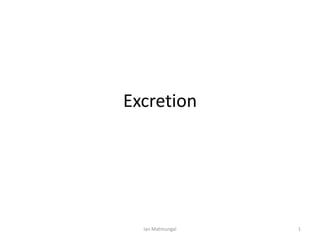
Excretion
- 1. Excretion 1 Ian Matmungal
- 2. Ian Matmungal 2 OBJECTIVES: You should be able to discuss the importance of excretion in animals; and give examples of excretory products and state the means by which they are eliminated.
- 3. What is excretion? Excretion is the removal of metabolic waste and excess metabolites from the body Excretion is different from Egestion, which is the removal of undigested waste from the alimentary canal, which is different from metabolic waste. Unicellular organisms can remove waste by diffusion across their cell membranes but complex organisms like animals require excretory organs. The main excretory organs in humans are the skin, lungs and kidneys. Ian Matmungal 3
- 4. Excretory Organs of the body Ian Matmungal 4 Excretory Organs
- 5. Excretory Products Carbon dioxide is produced as a waste product of respiration; high levels of it lowers pH level of blood, resulting in adverse effect on the chemical reactions in cells. Urea is produced by the liver as a result of deamination; its removal is carried out by the kidneys. Bile pigments comes from the breakdown of haemoglobin; the liver excretes bile containing bile pigments into the gut and the pigments will be removed as part of the faeces. Excess water and salts Ian Matmungal 5
- 6. The Kidney Ian Matmungal 6
- 7. OBJECTIVES: You should be able to: outline the function of kidney tubules in urine formation, with reference to ultrafiltration and selective reabsorption. Ian Matmungal 7
- 8. Structure of the Kidney Ian Matmungal 8
- 9. The Urinary System in Mammals: It consists of two kidneys (each found on each side of the vertebral column), a pair of ureters, a bladder and the urethra. In humans, the kidneys are embedded in a thick cushion of fat, slightly above waistline, for protection. The left kidney is slightly higher than the right kidney. Ian Matmungal 9
- 10. Kidneys receive blood from renal artery and return filtered blood to the circulation through the renal vein. Waste and water leave the kidney via the ureter, and is stored in the bladder as urine. As they accumulate, sense receptors in the bladdar are stimulated. Signals are sent to the brain to give the sensation of an urge to urinate. Urine is released from the bladdar through the urethra when the sphincter muscle is relaxed Ian Matmungal 10
- 11. Ian Matmungal 11
- 12. Each kidney has a solid outer cortex and an inner medulla. The functional unit of a kidney is the nephron. The nephron is responsible for carrying out waste removal and osmoregulation. Ian Matmungal 12
- 13. Ian Matmungal 13
- 14. Parts of the nephron A nephron consists of two main parts – the renal corpuscle and the renal tubule Renal corpuscle consists of Glomerulus Network of blood capillaries surrounding renal tubule Renal tubule consists of Proximal (first) convoluted tubule Loop of Henle Distal (Second) convoluted tubule Urine from several distal convoluted tubules are drained into a common collecting duct. Ian Matmungal 14
- 15. Ian Matmungal 15
- 16. Urine Formation Urine is produced by two main processes within the nephron: Ultrafiltration (occurs at the glomerulus) Filters out all small molecules from the blood Selective reabsorption (occurs at the kidney tubules) Reabsorbs the useful molecules from the kidney tubules back into the blood Ian Matmungal 16
- 17. Ultrafiltration Afferent arteriole branches into glomerulus Walls of glomerular capillaries have pores to allow small molecules (water, urea, glucose, amino acids) to be forced out into the Bowman’s capsule. The difference in diameter of the afferent and efferent arteriole generates a high hydrostatic pressure that provides the force for the molecules to be forced out of the glomerulus. Large molecules such as plasma proteins and red blood cells are retained in the blood. Ian Matmungal 17
- 18. Ian Matmungal 18
- 19. Selective Reabsorption The kidney reabsorbs useful substances from the glomerular filtrate into the blood at the proximal (first) convoluted tubule. (>80% of filtrate absorbed) All glucose, amino acids and some salts diffuse into the proximal convoluted tubule. They are actively transported into the interstitial fluid in between the cells and the blood capillary. As the filtrate becomes more dilute, water also leaves the tubule by osmosis. Ian Matmungal 19
- 20. Ian Matmungal 20
- 21. At the loop of Henle, the fluid is further concentrated by the transportation of salt out of the filtrate, setting up a greater concentration gradient at the base of the loop. The fluid reaches the distal convoluted tubule, where excess substances such as hydrogen, potassium ions, and drugs are secreted. The fluid flows through the collecting duct and passes the region where the concentration gradient was set up. The collecting duct reabsorbs water from the fluid and helps to regulate blood water concentration. Ian Matmungal 21
- 23. Outline the mechanism of dialysis in the case of kidney failure. Ian Matmungal 22
- 24. Homeostatic Control of Blood WaterConcentration – Osmoregulation The pituitary gland secretes the antidiuretic hormone (ADH), which enables the kidney to regulate blood water concentration. Changes in blood fluid levels is detected by the hypothalamus, which signals the pituitary gland to secrete more or less ADH. ADH increases permeability of distal convoluted tubule and collecting duct to water. Ian Matmungal 23
- 25. Ian Matmungal 24
- 26. When Kidneys Fail It can be due to high blood pressure and diabetes. A person with kidney failure needs dialysis in order to remove wastes from the body and prevent toxins from accumulating. Blood is drawn from a patient’s vein and pumped through a dialysis machine. The dialysis tubing is partially permeable. The dialysis fluid contains the same concentration of essential substances as the blood. The direction of blood flow is opposite to the flow of dialysis fluid. Ian Matmungal 25
- 27. Home Work Research how a dialysis machine works Ian Matmungal 26